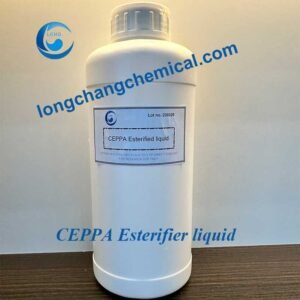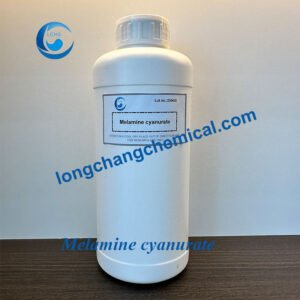CHLUMIFLARE®3-HPP/CEPPA
Nombre químico: Ácido 3-hidroxifenilfosfinilpropanoico
N.º CAS: 14657-64-8
Fórmula: C9H11O4P
Envase: 25 kg/bolsa/caja o 500 kg/bolsa.
Descripción
CHLUMIFLARE® 3-HPP/CEPPA
Sinónimo: Ácido 3-hidroxifenilfosfinilpropanoico; Ácido 2-carboxiletil(fenil)fosfínico
N.º CAS: 14657-64-8
Especificaciones:
| 3-HPP/CEPPA |
Forma sólida |
| Apariencia |
Cristal blanco |
| Contenido (HPLC) |
≥99.5% |
| Punto de fusión (DSC, °C) |
≥158 |
| Contenido en hierro (%) |
≤0.02 |
| Contenido de fósforo (%) |
14.0±0.5% |
| Contenido de iones de cloruro (%) |
≤10ppm |
| Índice de acidez (mg KOH/g) |
522.0±4.0 |
| Humedad (K.F, %) |
≤0.1 |
El retardante de llama de la fibra de poliéster (PET) se utiliza actualmente principalmente para añadir retardantes de llama o reactivos retardantes de llama a la estructura molecular con el fin de obtener un efecto retardante de llama. Los retardantes de llama aditivos sin halógenos no se adhieren eficazmente al poliéster. El efecto retardante de llama es generalmente deficiente en el hilo de fibra de éster, o el efecto retardante de llama no se mantiene, y no tiene una función retardante de llama permanente. y el retardante de llama fosforado 3-HPP/CEPPA es un retardante de llama reactivo sin halógenos, cuyo principio consiste en un chip de poliéster retardante de llama permanente sintetizado por copolimerización con ácido tereftálico (PTA) y etilenglicol (EG). Debido a que el 3-HPP/CEPPA participa en la reacción de polimerización, se forma una estructura macromolecular, por lo que se obtiene este producto. Las virutas de poliéster ignífugas tienen buena capacidad de hilado y resistencia permanente al fuego; este producto tiene un alto contenido de fósforo, elemento ignífugo (14,5 %), y un buen efecto ignífugo. Al sintetizar poliéster ignífugo, añada un 4-5 % (porcentaje en peso) de chips de fibra de poliéster fabricados con retardante de llama 3-HPP/CEPPA, el índice de oxígeno puede alcanzar el 32-33 %; la reactividad es buena y se pueden obtener chips de poliéster de alto peso molecular; no son tóxicos ni tienen sabor, y presentan una alta estabilidad térmica, estabilidad a la oxidación y resistencia al agua. Este producto es especialmente adecuado para los fabricantes de chips de poliéster para producir chips de poliéster ignífugos de alta calidad.
Embalaje: 25 kg/bolsa/caja o 500 kg/bolsa.
Aplicación:
Retardante de llama respetuoso con el medio ambiente, adecuado para la producción de productos de poliuretano retardantes de llama permanentes, como chips de poliéster, filamentos, fibras discontinuas, tejidos y películas. Los chips de poliuretano obtenidos tienen un buen tono y una buena capacidad de hilado. En comparación con el PET convencional, la capacidad de hilado de los productos de poliéster retardantes de llama tras añadir este producto tiene las mismas propiedades de hilado y tracción que los chips de poliéster convencionales. Productos de poliéster ignífugos Tiene una excelente estabilidad térmica, no se descompone durante el proceso de hilado y no desprende olores peculiares en el lugar de hilado. Puede mejorar el rendimiento antiestático de los productos de poliéster y tiene buena capacidad de hilado. La fibra tiene buenas propiedades de tejido y puede pasar por cualquier proceso de hilado. El sistema de seda realiza el procesamiento de hilado y el tejido puede obtener propiedades ignífugas permanentes. Cuando se copolimeriza con PTA y EG, la cantidad de aditivo es del 2,5 al 4,5 %, el contenido de fósforo de las virutas de poliéster ignífugas es del 0,35 al 0,60 % y el índice de oxígeno ignífugo después del hilado del tejido es del 30 al 36 %. Se utiliza ampliamente en campos ignífugos, como ignífugos textiles, ignífugos para hilado, ignífugos para fibras químicas, diversos materiales para prendas de vestir, tejidos decorativos, etc.
Almacenamiento:
Conservar en un almacén seco, limpio y bien ventilado.
Evitar la exposición a la luz y al calor.
Proteger el producto de fugas, lluvia y exposición al sol durante el transporte.
¡Póngase en contacto con nosotros ahora!
Si necesita el precio, rellene el formulario con sus datos de contacto y nos pondremos en contacto con usted en un plazo de 24 horas. También puede enviarme un correo electrónico a info@longchangchemical.com durante el horario laboral (de 8:30 a 18:00 UTC+8, de lunes a sábado) o utilizar el chat en vivo de la página web para obtener una respuesta rápida.
Can a shift in consumption structure lead to a shift in chemicals demand structure?
For the chemical market, in the current global market consumer market downturn under the general trend, the emergence of 618, whether to boost China's consumer market, so as to reverse drive the chemical consumer market "warming", is currently the chemical industry is very concerned about things.
For large home appliances and small home appliances used in the chemical materials, due to its application environment, body type and function of the different chemical materials used in the product there are differences.
First, the shell of the chemical materials used in the differences. The shell of large home appliances are mostly ABS, HIPS, etc., a small number of applications of PP, PC, ASA and other new materials, of which the application of ABS accounted for the largest proportion of air conditioners, washing machines and other shells are mostly ABS, the shell of the refrigerator is generally two kinds of materials, one is a steel plate, the other is a BS material. Steel plate is a common metal material, it has high strength, high hardness, not easy to deformation, etc., and the appearance of beautiful, durable.BS material is a polymer material, it has a lightweight, good toughness, impact resistance, etc., and a variety of colours.
Small appliances shell is mostly PC and ABS-based, but also choose steel, PP and so on. Such as air fryer shell is mostly ABS material, air deflector groove more PPS material. Sweeping robot shell is mostly ABS material, internal seals, tyres and other material applications there is also diversity.
Second, there are differences in the materials used for special internal parts. Different large home appliances, their internal functions are different, the material used also has a big difference. Air conditioner internal filter using mostly fibre materials, such as polypropylene fibre and polyester fibre and other materials, air outlet materials using flame retardant PP and flame retardant ABS materials, all modified plastics, the need to have a high degree of flame retardancy and so on. Refrigerator internal panels mostly use PMMA acrylic materials, freezer extraction mostly use antibacterial modified HDPE and transparent modified PP materials, there are a few ABS modified materials. Washing machine internal mostly use PP, HIPS, ABS materials, etc., there are flame retardant modified materials, enhanced toughened modified materials, etc..
For small home appliances, air fryers use PPS materials for their air guide grooves, which require high temperature resistance, dimensional stability and machinability. Rice cookers use steel inner liner, and the bottom wire connection materials use flame-retardant PP, flame-retardant ABS and other flame-retardant materials. The dust box inside the sweeping robot mostly uses HDPE injection material, and the tyres are mainly natural rubber and styrene-butadiene rubber tyres, which are resistant and easy to be processed.
Third, with the emergence of new electrical appliances, the application of electronic materials in home appliances is rapidly increasing. Such as "five constant" air conditioning, sterilization and deodorization of the fresh air system, can be connected to the washing machine and refrigerator, etc., these "smart" home appliances, a large number of the use of electronic materials, such as large-area touch panels and screens, and the Internet system requires new material products. In my opinion, these new appliances have a lot of potential.
In my opinion, these new home appliances are likely to be the main trend of upgrading China's home appliances, and will also drive the development trend of home appliance design and production. Under such a trend, a large number of electronic material products are expected to be used on home appliances, such as LCP, wet electronic chemicals, carbon fibres and composites, network hardware materials, PVA, PI, PET, PTFE, PVDF and so on.





Valoraciones
No hay valoraciones aún.